|
FACTORS AFFECTING WOMEN'S HEALTH IN DEMOCRATIC REPUBLIC
OF CONGO
CASE STUDY: BUTEMBO, LUBERO DISTRICT
A dissertation submitted to
The Institute of Ethics and Development Studies
In partial fulfillment of the requirements for the award of
degree of Bachelor of Arts
(Ethics and Development Studies)
Uganda Martyrs University
MEDHO KALUMBO SYLVAIN
[2005-03-ETH-038]
April 2009
DEDICATION
This research work is dedicated to my beloved family members,
Papa Eric Mongo, Mum Yvonne Ontoma, Mum Beatrice Medho, my late Sister Denise
Moke and my father Lou Michels, who had great love and interest in my education
and has unselfishly, laid the ground for me to reach the top. Mr. Theo Groot,
who was my first teacher and has, until now, guided me along my path of studies
at Uganda Martyrs University.
May the Almighty God bless them abundantly
ACKNOWLEDGEMENT
I wish to acknowledge the efforts of various individuals, who
contributed in one way or the other towards the study, 'Factors Affecting
Women's Health in Democratic Republic of Congo: Butembo, Lubero District,
North-Kivu Province'.
I appreciate and acknowledge the support of Sr. CECILIA MARY
DRARU of the Department of Ethics and Development Studies, Madam OKULLO NELLIE
of the Department of Education as well as of my supervisor, VIVIENNE LAING,
for their timely guidance, wisdom and invaluable comments at each stage of the
study.
I acknowledge the valuable information rendered to me by the
various people and NGOs: FEPSI & CFII, families, fellow students without
which this study would not have been a success.
I would like to recognize and thank my family for the
financial and moral support accorded to me.
ABSTRACT
This study was to find out factors affecting women's health in
the Democratic Republic of Congo (DRC). The objective of the research included:
to identify the major health problems of Women in post-conflict Butembo; to
identify the coping mechanisms used to combat health problems associated with
violence and the major causes preventing use of health care services. The study
was descriptive and mainly qualitative methods in design were used to carry out
and obtain information from the field. These included the use of interviews and
focus group discussions.
The findings show that women suffer from the common ailments
found in DRC; that they get very little information concerning their health and
have little extra resources to obtain preventative measures for example ITN.
The expected result of the study was that people would experience the effects
of war, but such effects were not mentioned. Nevertheless, data from a local
NGO - FEPSI - show that women suffer some forms of post traumatic shock
syndrome, but in a silent way. This has to do with lack of awareness but also
with traditional cultural norms. The latter means that «what happens
within the home should be kept into the home». General experience however
has shown that such behavior makes the situation only worse. It was therefore
recommended as a way forward that the Ministry of health should focus more on
health promotion and education in order to sensitize the communities on these
various issues.
It was also recommended that the health promoters, NGOs and
community development officers should discuss issues of domestic violence and
post traumatic stress symptoms with the people of Butembo district.
In conclusion, the district health department should liaise
with other sectors like education, agriculture and water supply services to
streamline health issues concerning Women.
LIST OF ACRONYMS
ARV: Anti Retro Viral
CFII: Centre de Formation et Information de
l'Ituri
DRC: Democratic Republic of the Congo
FEPSI: Femme Engagées pour la
Promotion de la Santé Intégrale
EWPSI: Engaged Women for Integral Health
Promotion
GPSALW: Gender Perspectives on Small Arms and
Light Weapons
HAC: Human Artificial Chromosome
HIV/AIDS: Human Immune Virus
/ Acquired Immune Deficiency Syndrome
NHIDMP: National Health Infrastructure
Development and Maintenance Plan
NGO: Non Governmental Organization
SGBV: Sexual and Gender Based Violence
ST: Sexually Transmitted
STD: Sexual Transmitted Diseases
UHB: Uganda Health Bulletin
UMU: Uganda Martyrs University
UN: United Nations
UNDP: United Nations Development Program
UNFPA: United Nations Programme for
Population Fund
WHO: World Health Organization
CHAPTER ONE
GENERAL INTRODUCTION
INTRODUCTION
The researcher based his research on factors affecting women's
health in Democratic Republic of Congo. It is organised chronologically in five
chapters all of which were crucial in the success of this study.
According to the Constitution of the World Health Organization
1948, health is defined as `a state of complete physical, mental, emotional,
intellectual, environmental, spiritual health, and social well-being and not
merely the absence of disease or infirmity' (WHO, 2004).
In order to justify health it is important not to ignore the
fact that health is fundamental to an individual's well being in many ways and
it is therefore independently valid. The Joint Initiative on the Fight against
Sexual Violence towards Women and Children of the United Nations
documented 41,225 cases in the provinces of Kivu, Maniema and Kalemi
in DRC since 1998 (WHO and HAC, 2005).
Services that address women's needs, especially when they are
subject to sexual violence, will reduce the impact of trauma, rates of
undesired pregnancy, and the incidence of sexually transmitted diseases (STDs)
and HIV infection. The specific purpose of such programmes is to
establish the best practices for health services that operate in conflict
period so that they promote women's health (with particular attention to the
needs of women exposed to acts of violence); to improving sexual and
reproductive health, reducing risks of HIV infection, and providing effective
health care to those who have acquired HIV and (seeking, where feasible, access
to ARV-based AIDS care). Through Women studies, the inequality between men and
women in health status and decision making has become clearer. The studies
indicate that in most cases women are at a disadvantage (Gender
and Health Promotion, 2007) and
therefore their health special attention needs to be paid to the issues
surrounding in conflict and post conflict.
Women's health and HIV/Aids
Women are affected by diseases such as Malaria, sexually
transmitted diseases, high-pitched respiratory infections, flu and diarrhoea
(Gender and Development, 2005). On the other hand, women's reproductive health
activities focus primarily on contraception safety and efficacy, fertility,
infertility, and HIV/AIDS and other sexually transmitted diseases. (STDs)
http://www.cdc.gov/reproductivehealth/WomensRH/index.htm
Women from socially and economically backward
groups have lower odds, both of having awareness of AIDS and knowledge of ways
to avoid getting the disease (Women's Health in
Today's Developing World, 2005). The spread of the epidemic to rural
areas presents a need to actively disseminate AIDS related knowledge
for health protection. Approaches to health promotion that do
not consider differing contextual factors are unlikely to succeed.
Therefore, an innovative strategy to disseminate knowledge among disadvantaged
population groups is needed. (Reproductive Health, 2005)
Factors affecting women's health
War
War is one of the factors that have affected Women's health in
Butembo from 1998 to 2003. Due to insecurity, people were forced to leave their
homes in the town and go to the villages for refuge and safety, escaping the
hostilities in Butembo. The women were exposed to sexual violence, rape and
other gender based violence by armed groups and also civilians (FEPSI-NGO,
2007). Sexual and gender based violence (SGBV) remains one of the greatest
threats to Women's Health.
Moreover, in the villages there were no health facilities of
any kind, no food, and no shelter.
After the war they returned home unfortunately few health care
units available services were offered so women and their dependants could not
access adequate healthcare, including safe contraceptive methods as a greater
proportion of money was directed to the war.
Societal: culture and patriarchal society
People in Butembo are of the Nande ethnic group. Like most
rural people throughout the DRC they speak one language, they have the same
tradition, culture, customs, which are derived from one ancestral line.
Among the Nande, Women have less rights in the family meaning
that men are privileged because of cultural beliefs. In every situation women
have to seek permission from their husbands except when it concerns health
issue whereby women are allowed to seek treatment according to their will.
BACKGROUND TO THE STUDY
Butembo
Butembo, the second town of the province after Goma is
situated in Lubero district, North Kivu province in the Eastern part of
Democratic Republic of the Congo. The citizens living in the town majority is
of Nande by tribe. Since independence 1960, the population has lived in poor
health conditions.
The inhabitants here suffer from various types of diseases
such as Malaria, TB, and HIV/AIDS but also reproductive health and
non-communicable diseases, such as those linked to Tobacco smoking.
Like most rural people through the country, the population of
Butembo depicts a low to average standard of living. As judged by the current
definition of poverty, which is the situation where one lacks most of the basic
necessities and assets for life or even any means of acquiring them.
Government health facilities
As mentioned before, most of the Government health facilities
countrywide have not been maintained or rehabilitated during and after war, and
many health centers and communities lack appropriate medical equipment and
staff (FEPSI-NGO, 2007). The Ministry of Health has recognized the importance
of maintenance and is in the process of developing a National Health
Infrastructure Development and Maintenance Plan (NHIDMP) as the priority for
health.
Study context
The study context is characterized by ongoing conflicts where
community systems including health systems are weakened, and easily
overwhelmed. Societal cohesion and the rule of law are undermined. Proposed
responses need to take into account the extreme challenges to their successful
study, development and implementation.
PROBLEM STATEMENT
War and society related to women's health
During the war in Butembo health facilities were destroyed and
rundown resulting into a deterioration of women's health. Even after the war
there are still factors affecting women's health. Among these include: Policy
reasons such as poor collaboration between health workers and the local
council; poor planning, and lack of material.
Goal
The overall goal of this study is to offer
suggestions that will help improve the impact of health services on the health
of women in post-conflict settings. As said before, services that better
address women's needs, especially when they are subject to violence, will
reduce the impact of trauma, rates of undesired pregnancy, and the incidence of
sexually transmitted diseases and also by ascertaining the effects of the war
on women's health and studying how women's health is after the cessation of
war.
RESEARCH OBJECTIVES
Main objective
To establish the factors relating to women's health in the
post-conflict situation that promotes women's health with particular attention
to the needs of women exposed to violent acts, improving sexual and
reproductive health, reducing risks of STD infections. While identifying
Different types of health care to those who have acquired, for example HIV/AIDS
and victims of different types of violence or rape.
Specific purpose
1. To identify the major health problems for women in
post-conflict Butembo
2. To identify the coping mechanisms used to combat health
problems associated with violence
3. To identify the major causes preventing use of health care
services.
RESEARCH QUESTION
What are the factors affecting women's health in Butembo
District?
HYPOTHESES
It is supposed that improving quality of care must begin with
the formation of human resources for health; a formation which should include
value, care process of men and women. However, what might be important is to
provide opportunities to female health workers to come together as women and as
professionals to provide care to the community.
Women's health may thus be improved in the way that women
engage themselves in public health services, which can play a big role in
improving quality of care.
Scope of the study
The scope of this study focused on the factors affecting
women's health, in Butembo, Lubero District as the case study. Data was
obtained from the NGO-FEPSI headquarter 63 Martyrs Road, Butembo town.
JUSTIFICATION
Diseases have had profound social and health consequences on
women in Butembo. Sometimes they remain mute and suffer silently from the
diseases and trauma. The outcome of this study will identify how healthcare
delivery can support women after identifying the factors which affect women and
their health. It will also identify healthcare gaps in service delivery, which
once identified can aid health planners and policy makers in provision of
services.
CONCLUSION
The chapter focused on the researcher's area of study, the
introduction, and the objectives that helped the researcher carry out his study
including the Significance and hypothesis of the study.
CHAPTER TWO
LITERATURE REVIEW
INTRODUCTION
Women's health is among the most important problems that
developing countries face. The magnitude of the women's health problem is so
important that it has affected their development.
The current concept of women's health should
be expanded to embrace the full spectrum of health experienced by
women, and preventive and remedial approaches to the major
conditions that afflict women. Allocation of health service
resources should be aligned with the epidemiological realities of
these threats to women's health,
(Women's Health in Today's Developing World,
2005).
What are the causes preventing use of health
care?
Income and loss of employment leads to poverty that can become
rampant and widespread in such a way that one cannot easily sustain him/herself
and provide the basic needs like food, shelter and maintenance of a good
quality of health, especially in post-conflict communities. The challenge is to
define the essential elements of women's reproductive health services, upgrade
the services as appropriate and reduce women's risks of disease and suffering,
(WHO, 2004).
What are the factors affecting women's
health?
WAR-effects on women's health
War is one of the major factors that affect Women's health.
Discrimination and gender difference are the most brutal consequences of war on
women's health. In war areas women are the most affected, especially those wars
in which the world's media take only token interest. For example, the incidence
of rape in Darfur, DRC, Northern Uganda and Sierra Leone may never be known,
let alone carry any hope of accountability. (
http://uk.oneworld.net/guides/uganda/development)
According to UHB (2000) the overall goal of organizations in
war, such as local and international NGO's is to improve the impact of health
services on the health of women caught up in violent conflict, or post-conflict
settings. Services that better address women's needs especially when they are
subject to situations like sexual violence will reduce the impact of trauma,
rates of undesired pregnancy, and the incidence of sexually transmitted disease
and HIV infection, (Uganda Health Bulletin, 2000).
SOCIETAL: CULTURE, PATRIACHIAL SOCIETY AND
HEALTH
In the majority of poor countries only a small proportion of
women will be engaged in paid employment which itself is likely to be of low
quality, (Senators and Representative, 2006).
According to the Global Policy (2006) in Asia a relative
important proportion of women are able to find employment. This is quite
different from Congo and for instance few women in Butembo think of having
work. Otherwise, they are mostly focused on agricultural work and business,
while Asian Women focus more on the business model of global corporations,
which typically engages them at the bottom of the production chain, for example
in factories.
HIV/AIDS
According to the Executive director of UNFPA - [Ms.Thoraya
Obaid], (2007) - HIV/AIDS constitute another big area of health factors
affecting Women. Part of it is that developing countries are facing critical
shortfalls of contraceptives and condoms. The solution to the HIV problem is
the combination of sex education, abstinence, couples remaining faithful to
their partners and greater use of condoms.
Gender Inequalities
According to UNFPA (2005) gender inequalities need to be
addressed including violence, limited access to education and violation of
human rights. When women are educated, healthy and employed, and able to make
decisions about childbearing and reproductive life, everyone benefits.
What are the major health problems for
women?
According to WHO (2005; 2007) being poor or being a woman
was often a reason for being discriminated. Worldwide, millions of women are
unable to protect themselves from HIV infection due to lack of prevention
methods that can be controlled by women, causing unnecessary suffering and
death. One of the most urgent actions is to increase funding for vaccine
development, proper nutrition and invest in education that will ensure they are
accepted within communities.
The Convention on Elimination of all forms of Discrimination
Against Women [adopted and opened for signature, ratification and accession by
General Assembly resolution 34/180 of 18 December 1979 entry into force 3
September 1981, in accordance with articles 27(1)] stipulates that «the
discrimination against women violates the principles of equality of rights and
respect for human dignity, is an obstacle to the participation of women, on
equal terms with men, in the political, social, economic field and in the
family and makes more difficult to realise the full development of the
potentialities of women in the service of their countries and of
humanity», (The conventions on the elimination of all forms of
discrimination against women, 1981).
http://www.mafhoum.com/press/51s4.htm,October 2007
According to Farr, (2002) health is not a gender issue, but a
poverty issue. It effects men as well as women and depends on the area they
live. For this to be seen as a woman issue is typical of real discrimination.
Women are the bearers of new life. In order to protect future
lives we must protect women. Promoting women's health physically and mentally
should be a top priority internationally. A progressive society can be measured
by the way that its women are treated. If women are healthy then their children
and families will have a greater chance of also being healthy and productive,
(Gender Perspectives on Small Arms and Light Weapons, 2002).
http://www.iansa.org/women, (September 2007)
There is no excuse for this grave human inequality. Women
should no longer be valued as second class citizens. If all the money that has
been poured into aid for third-world countries was used for a common benefit,
there would be no hunger and health problem in the world today.
http://disarmament.un.org/gender.htm
(September 2007)
Gender and health promotion
According to Östlin et al, (2007) women and
men are different as regards their biology, the roles and
responsibilities that society assigns to them and their position in
the family and community. These factors have a great influence on
causes, consequences and management of diseases and ill-health and
on the efficacy of health promotion policies and programmes.
What mechanism can be taken to combat health
problems?
Health promoting interventions aimed at ensuring
safe and supportive environments, healthy living conditions
and lifestyles, community involvement and participation, access
to essential facilities and to social and health services need
to address these differences between women and men, boys and
girls in an equitable manner in order to be effective, (Gender
and Health Promotion, 2007).
The different health measures showed considerable
variation in strengths of association with health related factors,
most noticeably so with gender and socio-economic status. The choice
of health measures in population studies should comply with the
intention to analyze its associations with any of those related
factors, or, in reverse, with the wish to prevent their confounding
properties, (Health Measures, 2007).
Extending the definition of women's health to
include a concern for chronic diseases is critical if the needs of
women in less developed nations are to be met. In less developed
countries, chronic diseases are the most important cause of female
death even during childbearing years and for women with young
families. Development agencies and private philanthropy must begin
to fund the studies that will further refine our understanding
of the role of chronic diseases in women's health in the
developing world, (Women's health in today's
developing world, 2005).
CHAPTER THREE
RESEARCH METHODOLOGY
Introduction
This chapter presents the research design, area and
population, as well as the sampling techniques research instruments and data
analysis and presentation.
RESEARCH DESIGN
It is descriptive in nature. A qualitative approach was used
to suggest ways of empowering Women to fight against diseases affecting their
health, looking at reasons for the situation the Women of Butembo face. The
research also looked at how to identify the root causes of diseases affecting
Women's Health in Butembo.
AREA OF THE STUDY
As far as the content of the study is concerned, the focus was
on factors affecting Women's Health in Butembo in collaboration with the local
NGO called FEPSI based in Butembo city in the North Kivu province (D R
Congo).
The respondents all come from different parts of the District
and from Butembo in particular.
SAMPLE SIZE
A total of fifty (50) women were targeted, which included
adolescents from 16 to 20 years, young married women from 20 to 30 years, and
women of 30 to 49 (Menopause) years.
DATA COLLECTION INSTRUMENTATIONS
Below are the methods and instruments used during data
collection;
Secondary sources
Literature review methods
This included using the library sources; that is reading and
reviewing journals and magazines about Women's Health, Gender and Development
and Primary Health Care that could give an insight.
The researcher also used internet sources with actual
information needed in the study.
Primary sources
· Interviews
With the help of a questionnaire the researcher conducted
interviews with the 50 women of the research sample.
However, during the interviews the researcher realized that
some respondents had expectations other than helping him for his research,
that's why there was a need to throw more light on certain points in order to
avoid any misunderstanding of the questions. This also allowed the researcher
to interact more with the respondents to get to see the real situation because
the interviews were conducted in the field.
DATA PROCESSING
The data collected from the field using interviews and
observation techniques were mainly qualitative and they were analyzed. This
makes this study explanatory.
LIMITATION OF THE STUDY
The respondents of the interviews were targeted through the
local NGO FEPSI. As a consequence of that, the data collected does not allow
the researcher to know whether this sample group is representative for the
whole population of women in the region of Butembo.
Another problem was in the fact that the participants
initially believed that extra help would come from this study, thus raising
their expectations. This was solved by carefully explaining that this was a
research study for degree purposes. Nevertheless it may be that some of the
respondents while answering were still expecting a reward.
ETHICAL CONSIDERATION
The researcher maintained maximum confidentiality of the
findings from the research. The researcher followed all the legal procedures to
reach the respondents such as getting a letter of introduction from the
university (UMU) and presenting it to the local government Office of Butembo
district and NGO-FEPSI. The researcher conducted out the research in person not
getting another individual to conduct the interviews or analyses. The research
being explanatory and exploratory on a social issue, namely factors affecting
Women's health, it called for ethical standards. For example, the researcher
was bound not to disclose the respondents' names in order to protect their
privacy and allow them to live normal lives. Each respondent's permission was
sought prior to answering questions.
Conclusion
This chapter gives information on the case study, how data was
collected, and shows how data was to be analysed. Limitations and delimitations
of the research are also presented in this chapter.
CHAPTER FOUR
DATA PRESENTATION AND DISCUSSION
Introduction
This chapter deals with research findings, analysis and
discussion on women's health merits and demerits as well as negative impacts of
non-health provision in Butembo District. The results of the study carried out
in Butembo District from 25th May to 6th July 2007 are
presented in consecutive diagrams.
WOMEN'S HEALTH IN POST WAR
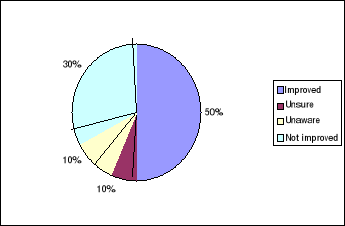
Figure 4.1: Women's health in post
war
The 10% shown on pie chat figure below, women stated, they
were unsure of their health status. This number of 10% if extrapolated over all
areas inflicted by war would be substantial and Health services may not
recognize or identify the causes of this uncertainty. This uncertainty may be
due to the situations these women found themselves during the conflict.
Fifty per cent stated that their health has improved. It is of
major concern that 30% claim no improvement in their health status. The most
serious and worrying issue is that 10% are unaware. This has major implications
for the future health of families and especially children, (FEPSI-NGO,
2007).
WOMEN'S MAJOR HEALTH PROBLEMS
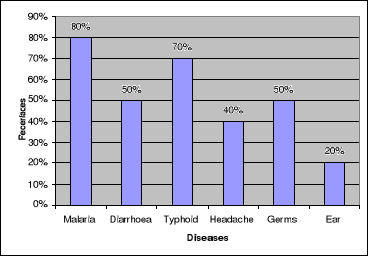
Figure 4.2: Women's major health
problems
As seen in figure 4.2 above, women stated illnesses which are
regular and not specific to war conditions, and there are no direct signs of
post traumatic stress disorder. The only notable illness that requires more
attention is headache, seen by the fact that 40% of the women said they
suffered regularly from this and is a symptom of stress. The worrying aspect of
this finding is that it is clear that health services are not addressing the
common disorders and moreover that mosquito nets that prevent malaria are not
used. All the diseases mentioned by the women are preventable.
Why women are experiencing these problems seems to be due to
the fact that there are no health promotion activities and although FEPSI is
treating the women, there is a gap in health services that would promote
women's health and educate the communities on ways to prevent illness.
WOMEN'S BETTER HEALTH CARE
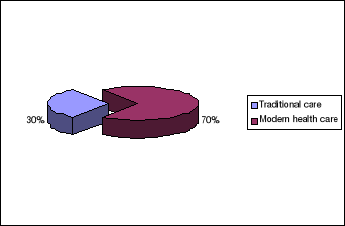
Figure 4:3. Women's better Health
care
70% of the Women interviewed go for modern treatment (as for
example in the FEPSI hospital). The other 30% (15/50) were influenced to use
traditional medicine for a number of reasons such as lack of money for
transport [even though treatment for instance in FEPSI hospital was free] or
because they believed the traditional medicine were found in the areas where
they live. Moreover, they have been using them for decades.
However, this figure clearly illustrate that the women were
ready to use the medical facilities especially if they were free, but also
because the services that are provided were influenced by the doctors
competency, fast services, skills and experiences.
CHALLENGES ENCOUNTERED IN TREATMENT
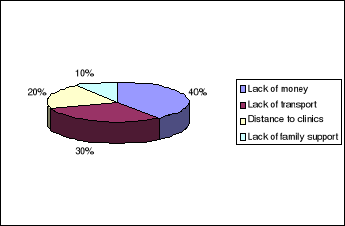
Figure 4.4: Challenges encountered
in treatments
Even though the FEPSI facility treatment was free, the women
still felt that the availability of money for health was a major set back
[Figure 4.4 above]. Caught with the long distance to this facility, shows that
access to services is still problematic even after over 4 years of peace in the
area. Health services are still few and women have long journeys to make to
seek services that they can afford.
WOMEN'S FORECAST ON HEALTH GROUNDS
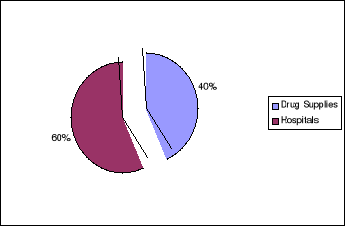
Figure 4.5: Women's forecast on
health grounds
To solve the above problems, solutions mentioned by the women
could be to construct more clinics (60 %) and to improve drug supplies (40 %).
However, construction requires a strong and resourceful health sector. This
can only be achieved with a country at peace and a steady and growing economy.
Also, the presence of health workers would be a help to the women.
WOMEN'S MOVEMENT DURING CONFLICT
40%
60%
Those who stayed
Those who fled

Figure 4.6: Women's movement
during conflict
Sixty percent (60%) of the women fled the town during the
conflict to the villages; thus health care remained poor. This resulted into
Women moving between the villages and towns, thus increasing their risk to the
consequences of war, since it was only in town that health services were
available.
HEALTH SERVICES DURING THE CONFLICT
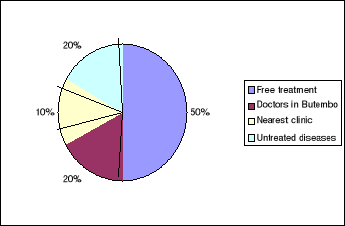
Figure 4.7: Health services during
the conflict
Fifty percent (50%) of Women stated they were getting free
treatment that helped them to maintain their health at normal levels but to
improve one's health conditions is the affordability of one's financial
positions. That is why. This situation was reported by 50% of women who do not
have access to afford a high health treatment.
USE OF MEASURES BY THE WOMEN TO MAINTAIN THEIR
HEALTH
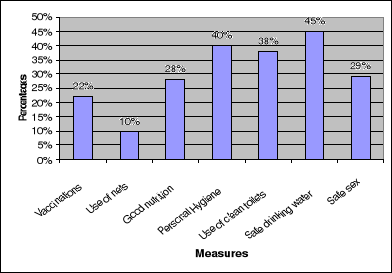
Figure 4.9: Use of measures by the
women to maintain their good health
It is clear that the women want good health for themselves,
and their families, but the constraints shown before in figure 4.4 clearly
indicate that they come to FEPSI because the treatment is free and they have
access to qualified doctors. As FEPSI not only treats, but offers health
education it is not surprising that the women know what they want and need to
have good health. These needs are there and some women try to go for it.
Nevertheless they need to attend more regularly to be realized. They need a
systematic response from all the sectors of government.
In conclusion the findings were based on the objectives.
CHAPTER FIVE
DISCUSSION, CONCLUSION AND RECOMMENDATIONS
introduction
This section presents the discussion, conclusion and
recommendations of the research; the study investigated the factors affecting
women's health in Democratic Republic of Congo. The studies major respondents
were the patients from the NGO-FEPSI in Butembo District, North Kivu
province.
DISCUSSION
In the study «Factors Affecting Women's Health in
Butembo» it was expected that Women would discuss the issue of domestic
violence as one of their challenges in health, but they did not talk about it.
However, In Butembo District, we know from research (FEPSI NGO, 2007) that
domestic violence against women is worsening. There are many different reasons
why women in Butembo could not discuss this issue. First, culturally it is a
taboo for «private» issues to be discussed in public. Also, if
sexual harassment is happening in homes there is the denial that there is a
problem accompanied by the trauma which has tortured the women both physically
and psychologically. Although both men and women are equal under the law,
within communities and tribes they are not equal in strength and power. That is
why they keep silent on these issues.
As shown by the United Nations (UN) General Assembly
resolution, it is stated that violence against women violates the principles of
equality of rights and respect for human dignity. However, there is a reason
why we could not focus more on domestic violence since it was not the main
problem raised by the women. However, we know that women suffer from all
aspects of domestic violence and that these are one of the major factors, which
affect women's health in Butembo district. This can be seen by the types of
problems raised such as the preponderance of headaches and stomach pains.
Since domestic violence is a silent trauma in Butembo, women
merely talked openly of other situations or diseases which were affecting them.
As expected, malaria was top on the list because of the fact that they did not
have freedom of asking their husbands for money. This disparity on accessing
funds is also affecting women's ability to access health care and the high
numbers attending the free facilities offered by the NGO.
From NGO-FEPSI workers it was found that a big number of women
received free treatment in their clinic. However, this had somehow an impact on
women's health whereby most of them did not care much about determining their
health in the sense that few could finish taking their dose of medicine. That
is why it was discovered that the same people after a certain period were
coming back in the clinic with the same health problem, but this was not stated
in the study and is one of the reasons women were having treatment more often
than men. This continual need to come for medical care may reflect the women's
way of coping with the trauma of what they had experienced and the seeking for
physical problems may be masking the mental stress that the women are
experiencing. Post traumatic stress can cause physical symptoms, but there is
lack of sufficiently skilled health personnel to deal with this, by recognising
the mental stress rather than continue with treating the physical needs to be
addressed.
In this research «Factors affecting women's health»,
women talked of distance and transport issues which came up in their view as
one of the factors which is affecting their health just because a hospital is
far from their homes and they cannot easily go for treatment by walking a long
distance when they are feeling weak. As a suggestion, women would like the
organisations, institutions and the government to construct more hospitals to
reduce the distance and cost and to increase supplies of drugs in health
sectors, to train more health workers in order to avoid all kind of problems of
women's health in future.
Conclusion
Since this research is based on Women's Health, it has been
stated in the introduction that women are most affected by diseases such as
malaria, sexually transmitted diseases, flu and diarrhoea.
Since war is a main factor which gives a gap to a number of
factors affecting women's health, armed conflict often leads to a reduction in
formal medical or psychological support for home-based care, most of whom are
women. Sexual transmitted diseases against women are rampant during the war and
have reached epidemic proportions. The risks do not end when the war is
officially over; the number of diseases in the community increases with the
return of the women back home.
RECOMMENDATIONS
The Ministry of Health needs to focus more on health promotion
and health education to sensitise the communities on various issues in health
sector that affect their livelihood. In other hand, the ministry should also
carry out researches in order to know what are the problems or factors
affecting the communities. Through this, the communities will be in position to
be treated and aware of what is affecting them.
The Ministry of Health needs to mainstream gender in all
sectors by equal participation of both men and women in health promotion. This
will help the citizens to work hard in order to improve their health without
the ministry intervention.
Butembo Health promoters, NGOs and community development
officers have to discuss issues of domestic violence and post traumatic stress
symptoms with the people of Butembo district.
District Health Department needs to liaise with other sectors
(education, agriculture, water, etc) to work together to promote development
issues and to mainstream the three main cross-cutting issues.
The Ministry of health has to implement primary health care
services in the zone affected by conflict and in the rural areas.
Conclusion
This chapter gives information on the discussion, conclusion
and recommendation whereby various issues such as violence against women,
distance and transport to the clinic were raised. Apart from these, factors
like war, diseases and number of recommendations are also presented in this
chapter.
APPENDICES
APPENDIX i
QUESTIONNAIRE
Background of information
Age: --------------- Sex. :
----------------------
Qualification: -----------------------------------------
Occupation: --------------------------------------------
Marital Status: ----------------------------------------
1. What has been your health since peace came to Butembo?
--------------------------------------------------------------
----------------------------------------------------------------------------------------------------------------------------
2. Did you have any major health problems over the last few
years related to the war?
------------------------------------------------------------------------------------------------------------------------------------------------------------------------------------------
3. What did you do to get back to good health?
------------------------------------------------------------------------------------------------------------------------------------------------------------------------------------------
4. Do you decide yourself if you need to attend the doctor?
------------------------------------------------------------------------------------------------------------------------------------------------------------------------------------------
5. What influences you to attend the doctor?
------------------------------------------------------------------------------------------------------------------------------------------------------------------------------------------
6. What are the major problems you face in seeking health
care?
------------------------------------------------------------------------------------------------------------------------------------------------------------------------------------------
7. What in your opinion could solve these problems?
------------------------------------------------------------------------------------------------------------------------------------------------------------------------------
8. Did you stay in Butembo or did you flee? If yes ask
for :(b)----------------------------------------------------------------------------------------------------------------------------------------------------------------------------------
If no ask for
(a)---------------------------------------------------------------------------------------------------------------------------------------------------------------------------------------
9. a. What were the health services like when you returned to
Butembo?
------------------------------------------------------------------------------------------------------------------------------------------------------------------------------------------
9. b. What were the health services like during the
conflict?
------------------------------------------------------------------------------------------------------------------------------------------------------------------------------------------
10. What in your opinion can improve the health services
offered to you in Butembo?
------------------------------------------------------------------------------------------------------------------------------------------------------------------------------------------
11. What kind of measures do you take to maintain good
health?
------------------------------------------------------------------------------------------------------------------------------------------------------------------------------------------
APPENDIX ii
TIME FRAME
|
TIME
|
ACTIVITY
|
RESULTS AT THE END
|
|
1st Week of Research (May 2007)
|
Seeking permission from authority team leaders and getting
familiar to the place.
|
Permission got
|
|
2nd Week of Research (Jun 2007)
|
Collecting data from selected sample.
|
Data collected ready for analysis
|
|
3rd Week of Research (October 2007)
|
Computing and analyzing of data
|
Data ready for drafting
|
|
4th Week of Research (November 2007)
|
Drafting the research book
|
Final draft ready
|
APPENDIX iii
THE MAP OF D.R. CONGO SHOWING THE LOCATION OF BUTEMBO
TOWN WITH ARROW (Uganda side)

BIBLIOGRAPHY
Abdoulie Sanneh et al (2005).Reproductive health and socio
cultural correlates, Journal of Public health, Publisher Oxford University
press.
Department of Disarmament Affairs (2001) The Office of the
Special Advisor on Women's Issues, Gender and Disarmament Fact Sheets: 24
Bonn International Centres for Conversion.
Duetz et al (2003). Health measures,
Publisher the European Journal of Public health, Switzerland.
Farr, Vanessa (2002). Gender Perspectives on Small Arms and
Light Weapons, Regional and International Concerns, Brief 24 Bonn
International Centre for Conversion.
Piroska Östlin et al (2007). Gender
and health promotion, Publisher
Oxford University press.
Susan U Raymond et al (2005). Women's
health in today's developing world, Publisher British
Medical Journal.
Internet source:
http://disarmament.un.org/gender.htm
http://www.iansa.org/women (September, 2007),
http://www.cdc.gov/reproductivehealth/WomensRH/index.htm
http://www.mafhoum.com/press/51s4.htm
http://uk.oneworld.net/guides/uganda/development
| 


